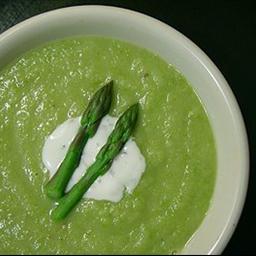Spring it up with Asparagus
Spring offers such a splendid visual palette of color and texture that I can’t help but feel joy! Flowers are blooming everywhere I turn. Fresh and vibrantly green leaves emerge on trees and shrubs. My lawn grows so fast it almost needs mowing twice a week. Weeds pop up all the places I’d rather not have them. Birds are all a twitter, busy with the duties of the season. Fruit trees blanket themselves in flowers with the anticipation of providing abundant globes of deliciousness. And….. asparagus spears poke their tips through moist soil, tender and green and loaded with health promoting vitamins, minerals and antioxidants. What’s not to love about SPRING I ask?!? Asparagus is packed with the super star antioxidant, glutathione. In fact it contains more glutathione than any other vegetable or fruit. And for those of us who have had cancer, rich sources of antioxidants are a wise choice in our diet. In addition, asparagus contains the soluble fiber, inulin, which helps beneficial bacteria flourish in the lower intestine. Asparagus is also an excellent source of vitamins K, C and A as well as the B vitamin Folate. Interestingly, high folate levels are thought to reduce blood levels of homocysteine, which is an amino acid that’s linked to cardiovascular disease and dementia.
When shopping for asparagus, look for spears that are firm with a bright green color and tips that are closed. Select spears that are about a 1/2 inch in diameter, approximately the thickness of your little finger. Ones that are much thinner than that can be easily overcooked, while spears that are thicker can be woody, tough and stringy, and often require peeling and more time to prepare. Spears should be as uniform in size as possible so they’ll cook evenly.
Store your fresh asparagus in the refrigerator in a tightly sealed plastic bag to slow the respiration rate. I’ve also found it helpful to cut off an inch or so from the bottom of the spears and then stand them upright in a large glass or a tall sided plastic container that has one to two inches of water in the bottom. This re-hydrates the spears just as if they were fresh cut flowers. I then like to cover the upright spears with a plastic bag for additional moisture retention. I use this same technique for my kale, collard greens and Swiss chard. They keep so much longer in the refrigerator when I do this. I've even re-hydrated broccoli that was a little limp by using this method. It’s amazing!! Remember though to cut at least a ½ inch from the bottom of the stems in order to open up the vascular system.
This month I’ve included an Asparagus soup recipe from Rebecca Katz’s new cookbook, “The Longevity Kitchen”. I highly recommend that you don’t skip any of the toppings that she suggests. They superbly enhance the flavor of the soup! Wishing you nourishment and joy this spring! Diane
Spring Is Busting Out All Over Soup
 The Longevity Kitchen – Rebecca Katz
The Longevity Kitchen – Rebecca Katz
Ingredients: 2 tbsp. olive oil 1 cup finely chopped yellow onion Sea salt Freshly ground black pepper 1 cup finely chopped leek, white part only 1 tbsp. finely diced shallot 2 tsp. minced garlic 1/4 tsp. dried thyme 2 pounds fresh asparagus, tough ends snapped off and discarded, then cut into 1/2 inch pieces 1/3 cup frozen peas, thawed 6 cups vegetable stock or chicken broth, home-made or store bought 1/4 cup finely chopped fresh parsley 2 tsp. freshly squeezed lemon juice Organic plain yogurt, for garnish 1 tbsp. chopped fresh mint, for garnish Chive oil for garnish
Directions: Heat the olive oil in a skillet over medium heat. I like to simultaneously heat a few tablespoons of water along with the olive oil so that I can reduce the amount of oil I use. Add a pinch of sea salt and a pinch of pepper and sauté until golden, about 8 minutes. Add the leek and shallot and sauté for 5 minutes. Stir in the garlic and thyme. Add the asparagus, 1/4 tsp. of salt, and 1/4 tsp. of pepper and sauté for 3 minutes. Stir in the peas. Pour in 1 cup of the broth to deglaze the pan. Cook until the asparagus is just tender. Remove from the heat.
Pour 1 1/2 cups of the broth into a high speed* blender. (*See Note below*) Add one-third of the vegetable mixture and blend until smooth. Transfer to a soup pot over low heat and repeat the process two more times, using 3 cups of the remaining broth. Stir in the parsley, lemon juice, 1/4 tsp. sea salt, and the remaining 1/2 cup broth. Cook just until heated through. Taste; you may want to add a squeeze of lemon juice and a couple pinches of salt. Serve garnished with a dollop of yogurt, a sprinkling of the mint, and a drizzle of Chive oil.
Chive Oil: 1/2 cup chopped fresh chives 1/2 cup olive oil Pinch of sea salt Put all of the ingredients in a blender and process until smooth. Use as a drizzle of YUM on top of soups, salads and fish.
Note: Because asparagus can sometimes be fibrous, it is best to use a high speed blender like a Vitamix or Blendtec. If you don't have one of these, make sure your blender is a good one and has a very high speed so that the fiber will be macerated.

